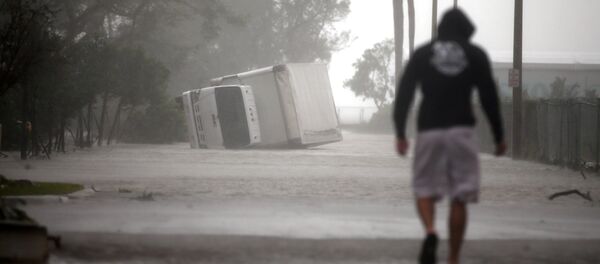Kristian Rouz – In line with earlier projections, US economic growth took a blow last month, as Hurricane Harvey affected America's economic powerhouse, Texas. Retail sales declined as the hurricane caused disruptions in consumer activity far beyond Texas due to the jump in petrol prices.
US manufacturing, meanwhile, suffered a dramatic contraction compared to the one during the Great Recession, as oil rigs and refineries in Texas idled for an extended period of time, cutting fuel supplies to other sectors of the US industrial production.
"The third quarter is going to look very soft, and most of that will reflect the near-term impact of the storms," Richard Moody of the Birmingham, AL-based Regions Financial Corp. said.
Hurricane Irma, which hit Florida in early September, is poised to affect the economy in a similar fashion, suppressing Q3 growth in accordance with earlier projections from Goldman Sachs. However, the economy is forecast to post a solid rebound closer to the yearend, especially so if Donald Trump delivers on his tax plan.
US manufacturing is the worst-affected sector of the economy in Harvey's aftermath. According to a separate report from the Federal Reserve, US industrial output contracted by 0.9 percent in August in its biggest drop since mid-2009, snapping a six-month period of robust expansion.
The Federal Reserve said the hurricane itself slashed manufacturing output by 0.75 percent as the storm "temporarily curtailed drilling, servicing, and extraction activity for oil and natural gas."
"The third quarter is looking weaker now, but it's a temporary weakness," Nariman Behravesh of HIS Markit said. "The economy was picking up some steam" before the hurricanes, and "the underlying dynamics are still quite strong. Consumer spending is very solid, and exports are starting to pick up," he added.
The Atlanta Fed's GDPNow tool shows that Q3 growth is likely to slow to 2.2 percent compared to an earlier projection of 3 percent. British bankers, Barclays, say the US economy will expand by 2 percent at best in the current quarter, because Florida and Texas are amongst the most important states economically, as significant manufacturing capacity is concentrated there.
Unlike the ‘Rust Belt', the American South hasn't lost in manufacturing capacity in the past two decades as it has been mostly reliant of hi-tech and petrochemicals, rather than the production of durable consumer goods such as cars in Detroit, which couldn't stand the overseas competition.
Previously, Barclays' experts expected the US 3Q17 growth to reach 2.6 percent, citing the Trump administration's deregulation of the economy encouraging business activity.
As for a rate hike, which might happen in December unless the Fed policymakers are too alerted over the debt ceiling debate due that month, the central bank is looking at the still-underperforming inflation.
There is currently little certainty over the timeline of the new US economic policies, even though the direction is apparent. The Trump administration's efforts aimed at rebuilding Florida and Texas — for which the federal government went $300 bln deeper into debt in a single day, on September 8 — are poised to set a blueprint for the fiscal stimulus package and its application in other states.





